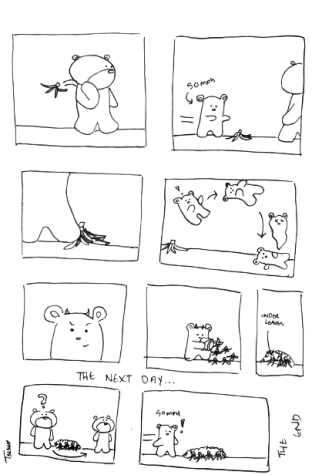Activism Through Artistic Expression: The Legend of Banksy
From President Barack Obama’s “Hope” to Art Spiegelman’s “Maus,” political art has encouraged change and reform across a wide spectrum of society. One such artist pushing for reform is Banksy, an English-based graffiti artist, political activist, and film director whose real identity is unknown. His satirical street art is characterized by his original stencil technique. Banksy displays his art in public places, often illegally, such as in the Calais migrant jungle and the south bank of London. Banksy has sparked intrigue and controversy across the world with his minimalistic distinct style with some hating him and many more adoring him.
Banksy’s real identity is unknown but the general consensus among the masses is that he is London-based. He has approached themes such as the migrant crisis, the new generation and their technology affliction, and political corruption. His early works, dating back to 1992, were inspired by Bristol’s bustling underground graffiti scene. It was during this time that he met a Bristol based photographer named Steve Lazarides, who later became his agent, selling Banksy’s artwork. Banksy’s first works were dealing with the issues of war, capitalism, and flaws in the world’s exploitation of post colonized countries. Banksy became a well known artist in July of 2011 when he stenciled the Gorilla in the Pink Mask onto the exterior wall of a well known club in Eastville. Banksy is viewed as a staunch proponent of raising awareness of injustices, something that CHS students could draw from when looking at the world.
“There are crimes that become innocent and even glorious through their splendour, number and excess,” Banksy said to The Huffington Post.
Banksy gained widespread popularity in 2008 when Christina Aguilera bought the original painting of “Queen Victoria” for £25,000. Shortly after this, an unknown buyer bought “Bombing Middle England” for £102,000. In 2010, his satirical documentary “Exit Through the Gift Shop” premiered at the Sundance Film Festival. The documentary, directed by Banksy, dealt with the story of Thierry Guetta and his obsession with street art. Banksy is often described as a “vandal” or “delinquent” because of his style of painting. Time Magazine writer Shepard Fairey effectively describes Banksy’s style.
“Banksy paints over the line between aesthetics and language, then stealthily repaints it in the unlikeliest of places. His works, whether he stencils them on the streets, sells them in exhibitions or hangs them in museums on the sly, are filled with wit and metaphors that transcend language barriers,” Fairey said to Time Magazine.
Banksy and his distinct style are recognizable and often hide subliminal political messages behind their artwork. Even though Banksy is sometimes viewed as a vandal, he continues to raise awareness about worldly problems, such as greed, poverty, hypocrisy, boredom, despair, and consumerism through small, local art pieces. What Banksy has done really goes to show how powerful a simple political art piece may be and how it can encourage social change and reform, which is something CHS students could aspire to do.
Hello there! Our goal is to provide relavent, engaging journalism for readers of all ages. Your donation will support the student journalists of the Wolfpacket at Claremont High School, and will allow us to purchase equipment, print our monthly issues, and enter in journalism competitions. We appreciate your consideration!






